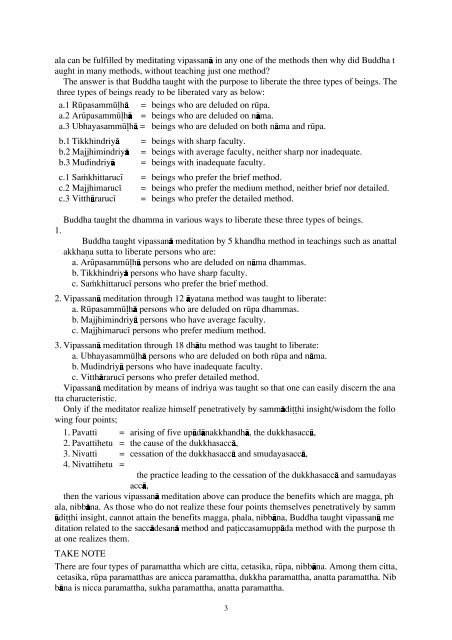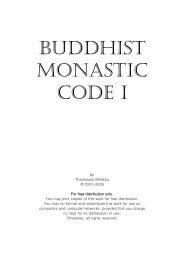Vipassana Kammatthana.pdf
Vipassana Kammatthana.pdf
Vipassana Kammatthana.pdf
Create successful ePaper yourself
Turn your PDF publications into a flip-book with our unique Google optimized e-Paper software.
ala can be fulfilled by meditating vipassanå in any one of the methods then why did Buddha t<br />
aught in many methods, without teaching just one method?<br />
The answer is that Buddha taught with the purpose to liberate the three types of beings. The<br />
three types of beings ready to be liberated vary as below:<br />
a.1 RËpasammˬhå = beings who are deluded on rËpa.<br />
a.2 ArËpasammˬhå = beings who are deluded on nåma.<br />
a.3 Ubhayasammˬhå = beings who are deluded on both nåma and rËpa.<br />
b.1 Tikkhindriyå = beings with sharp faculty.<br />
b.2 Majjhimindriyå = beings with average faculty, neither sharp nor inadequate.<br />
b.3 Mudindriyå = beings with inadequate faculty.<br />
c.1 Sa◊khittaruc¥ = beings who prefer the brief method.<br />
c.2 Majjhimaruc¥ = beings who prefer the medium method, neither brief nor detailed.<br />
c.3 Vitthåraruc¥ = beings who prefer the detailed method.<br />
Buddha taught the dhamma in various ways to liberate these three types of beings.<br />
1.<br />
Buddha taught vipassanå meditation by 5 khandha method in teachings such as anattal<br />
akkhaˆa sutta to liberate persons who are:<br />
a. ArËpasammˬhå persons who are deluded on nåma dhammas.<br />
b. Tikkhindriyå persons who have sharp faculty.<br />
c. Sa◊khittaruc¥ persons who prefer the brief method.<br />
2. Vipassanå meditation through 12 åyatana method was taught to liberate:<br />
a. RËpasammˬhå persons who are deluded on rËpa dhammas.<br />
b. Majjhimindriyå persons who have average faculty.<br />
c. Majjhimaruc¥ persons who prefer medium method.<br />
3. Vipassanå meditation through 18 dhåtu method was taught to liberate:<br />
a. Ubhayasammˬhå persons who are deluded on both rËpa and nåma.<br />
b. Mudindriyå persons who have inadequate faculty.<br />
c. Vitthåraruc¥ persons who prefer detailed method.<br />
Vipassanå meditation by means of indriya was taught so that one can easily discern the ana<br />
tta characteristic.<br />
Only if the meditator realize himself penetratively by sammådi hi insight/wisdom the follo<br />
wing four points;<br />
1. Pavatti = arising of five upådånakkhandhå, the dukkhasaccå,<br />
2. Pavattihetu = the cause of the dukkhasaccå,<br />
3. Nivatti = cessation of the dukkhasaccå and smudayasaccå,<br />
4. Nivattihetu =<br />
the practice leading to the cessation of the dukkhasaccå and samudayas<br />
accå,<br />
then the various vipassanå meditation above can produce the benefits which are magga, ph<br />
ala, nibbåna. As those who do not realize these four points themselves penetratively by samm<br />
ådi hi insight, cannot attain the benefits magga, phala, nibbåna, Buddha taught vipassanå me<br />
ditation related to the saccådesanå method and pa iccasamuppåda method with the purpose th<br />
at one realizes them.<br />
TAKE NOTE<br />
There are four types of paramattha which are citta, cetasika, rËpa, nibbåna. Among them citta,<br />
cetasika, rËpa paramatthas are anicca paramattha, dukkha paramattha, anatta paramattha. Nib<br />
båna is nicca paramattha, sukha paramattha, anatta paramattha.<br />
3






